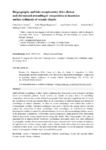Biogeography and lake morphometry drive diatom and chironomid assemblages’ composition in lacustrine surface sediments of oceanic islands

Use este enlace para citar
http://hdl.handle.net/2183/18283Coleccións
- GI-GRICA - Artigos [49]
Metadatos
Mostrar o rexistro completo do ítemTítulo
Biogeography and lake morphometry drive diatom and chironomid assemblages’ composition in lacustrine surface sediments of oceanic islandsAutor(es)
Data
2014Cita bibliográfica
Pereira, C.L., Raposeiro, P.M., Costa, A.C. et al. Hydrobiologia (2014) 730: 93. doi:s10750-014-1824-6
Resumo
[Abstract] Subfossil biotic assemblages in lakes’ surface sediments have been used to infer ecological conditions across environmental gradients. Local variables are usually the major drivers of assemblage composition, but in remote oceanic islands biogeographic filters may play a significant role. To assess the contribution of local and regional filters in the composition of subfossil diatom and chironomid assemblages in surface sediments, 41 lakes in Azores archipelago were studied and related to environmental variables. Ordination techniques were used to identify the forcing factors that best explain the composition of these assemblages. Both assemblages are influenced by multiple limnological variables (conductivity, pH and nutrients). However, diatom assemblages differed mainly in the proportion of planktonic versus benthic species along lakes’ depth gradient while chironomids differed significantly among islands but not among lake depths. Thus, biogeographic filters play an important role in shaping islands’ freshwater communities, particularly insect ones, more influenced by geographic variables. Results demonstrate the accuracy and potential of biotic remains in sediments for applied studies of lake ecology, trophic status, climatic trends and ecological reconstruction and evolution of lakes. In the Azores, the application of this information for the development of inference models is envisaged as a further step to accomplish these goals.
Palabras chave
Azores
Chironomid assemblages
Diatom assemblages
Local and regional filters
Oceanic islands
Surface sediments
Chironomid assemblages
Diatom assemblages
Local and regional filters
Oceanic islands
Surface sediments
Versión do editor
Dereitos
The final publication is available at Springer via https://doi.org/10.1007/s10750-014-1824-6
ISSN
1573-5117





